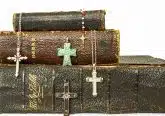Question of Faith: Holy Water at Home?
When I was young, we kept holy water in a small font at the entrance to our bedrooms. What is the origin of the practice? Can we still use holy water in our homes?
When entering a church building, we reflexively sign ourselves with holy water. In doing so, we are participating in an ancient tradition. Water as a symbol of cleansing and purity has pre-Christian origins. Our Jewish forbearers saw water as a spiritual symbol with spiritual effects. God commanded Moses and the Israelites, for instance, to wash before worship: “When they approach the altar to minister, to offer an oblation to the Lord, they must wash their hands and feet, lest they die” (Ex. 30: 20-21).
AS A SACRAMENTAL
The Church considers holy water to be a sacramental, a sacred sign that bears a resemblance to the sacraments. It is closely connected to baptism, among other sacraments, and is symbolic of Christ, who called himself “living water” and who is the font of eternal life. It reminds us, too, of Christ, the saving victim from whose side blood and water flowed, an allusion to the Church and the sacraments.
The first Christians may have used holy water. According to one tradition, the Gospel writer St. Matthew blessed holy water. An early form of blessing holy water was attributed to Pope Alexander in the early 2nd Century. The Apostolic Constitutions, an ancient document showing liturgical and sacramental practices, indicates belief in the power of holy water. Through Christ, the water was granted “power to restore health, to drive away diseases, to banish demons, and to disperse all snares.” Holy water, partly because of its connection to baptism, became closely connected to warding off evil.
IN THE LITURGY
Holy water can be blessed as part of Mass or apart from it. The practice of Christians placing holy water at the doors of churches probably originated from the Jewish custom of ceremonial washing in preparation for making sacrifices. In its earliest use in churches, worshipers took it upon entering the church but not upon leaving, a reminder that purification was only needed when approaching the house of God. Eventually, the water was taken any time one passed the font.
The use of water as part of the sacrament of baptism was probably the root of clergy formally blessing it. Today, the rite of blessing can take various forms and can include the exorcism and blessing of salt (a symbol of protection from corruption) to be mixed with the water. What is essential in the blessing of water is the prayer itself (“Lord our God … graciously + bless this water …”). A longer form of blessing, which can be adapted, includes a reading from Scripture.
IN THE HOME
Once blessed, the water is available in fonts in churches. The faithful are welcome to fill a small bottle or another receptacle to take the water home. The water can be placed in a font within the home, often hung on the wall near a doorway, or it may remain in the bottle. Holy water can be used for blessing oneself or for parents to bless their children. It serves as a tangible sign of Christ and a reminder of the rites of the Church that use water, including baptism and Eucharist.
Whenever we dip our hand in holy water, we participate in a powerful and ancient sacramental. As in the past, the faithful are encouraged to take water home as a means of blessing and a reminder for one’s home and family life to image Christ.
 Father David Endres is associate professor of Church history and historical theology at Mount St. Mary’s Seminary & School of Theology.
Father David Endres is associate professor of Church history and historical theology at Mount St. Mary’s Seminary & School of Theology.
This article appeared in the July 2021 edition of The Catholic Telegraph Magazine. For your complimentary subscription, click here.














